What Veggies Go Good in Korean Beef?
Yukgaejang is a hearty, spicy beef soup made with shredded beefiness, lots of scallions and other vegetables. Perfect soup for cold days ahead!
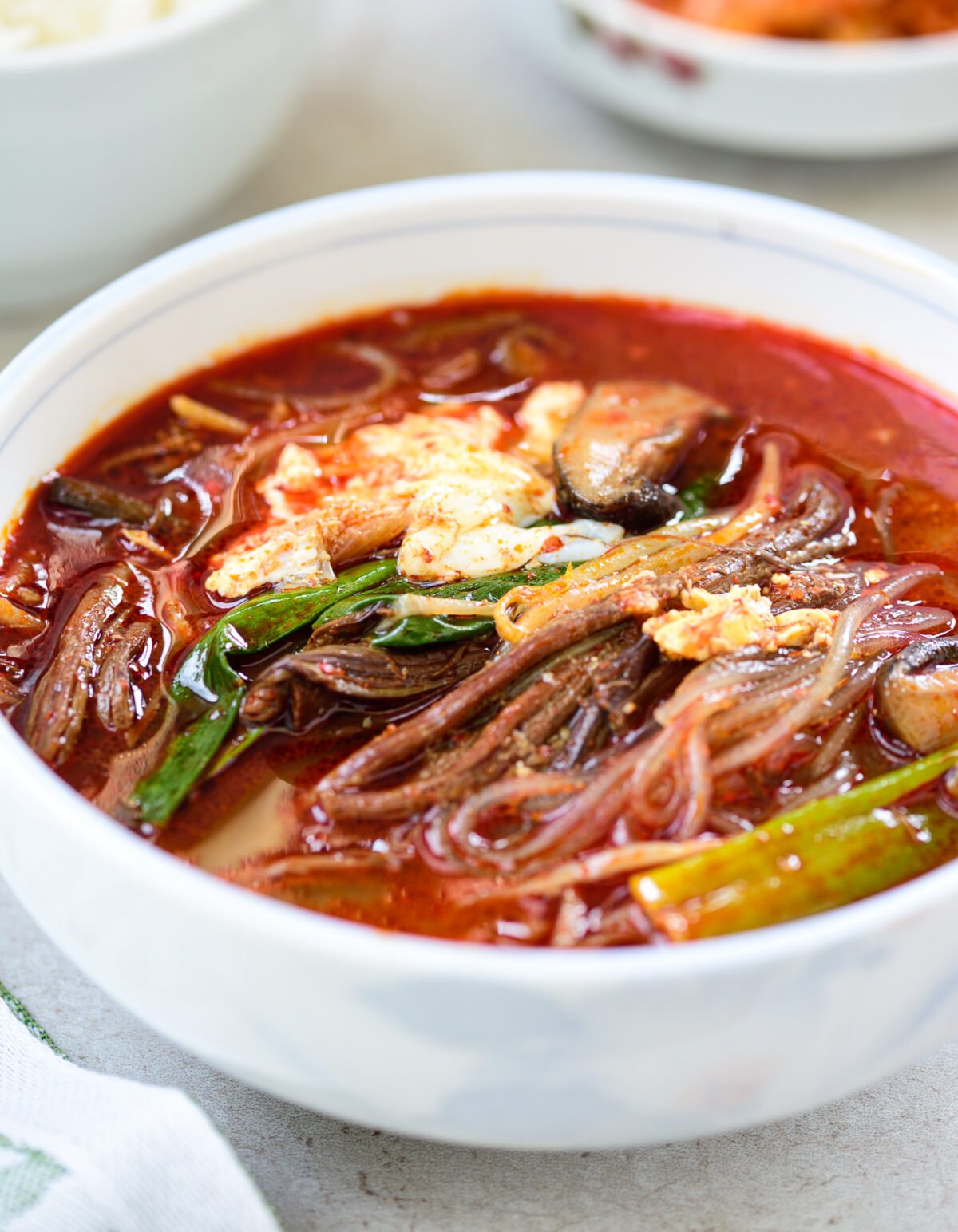
Yukgaejang (육개장) is a hearty, spicy beefiness soup that's highly popular in Korea. Made with shredded beefiness, lots of scallions (pa, 파) and other vegetables such as gosari (fernbrake fiddleheads), beansprouts, and mushrooms, this is a substantial soup that has a great depth of flavour.
You won't need anything other than a bowl of rice for a completely satisfying meal on a common cold winter day. In Korea, yukgaejang is besides popular as nourishing soup that helps fight the summer heat.
As we do with many Korean soups, we frequently savour this soup with some rice mixed in. Some people prefer to keep the rice and soup separately while eating. What'southward your preference?
Which cut of beef to use
Beefiness brisket (yangjimeori, 양지머리) is the typical cut for this soup and many other Korean soups. Information technology'southward a flavorful, tough cut of meat that's great for making goop. When properly boiled, the meat turns pull-apart tender, making it ideal for this soup. Yous can also use flank steak (chimasal, 치마살) or shank meat (satae, 사태).
If chicken is used instead, the soup is then called dakgaejang (닭개장).
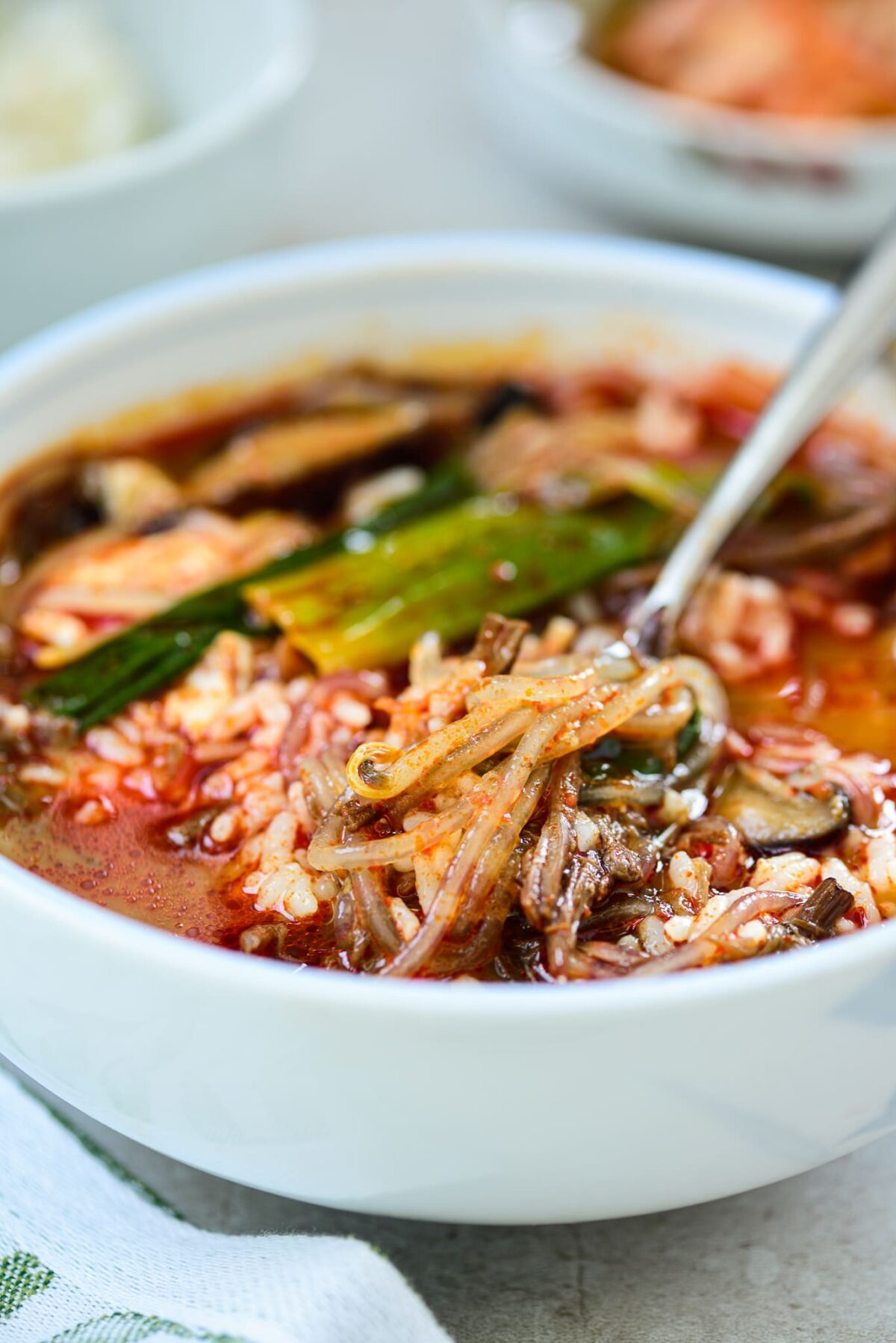
Vegetables
If you desire to apply merely one vegetable for this soup, information technology should be scallions. Lots of them! After the beefiness, this is the well-nigh important ingredient for this soup. In Korea, the large diverseness dark-green onions, called daepa (대파), are used for soups. No, they are not the aforementioned every bit leeks. Daepa is packed with unique sweet oniony flavour. It actually elevates the tastes of soups!
Luckily, daepa now is available at Korean markets around hither, specially during fall and winter.
There are other similar beef soups in Korea, simply gosari (fernbrake fiddleheads) is unique in this soup. You can buy dried gosari (고사리) at any Korean market and rehydrateby a combination of soaking and boiling in water. Look for the ones with short, thin stems.
Besides adding soft, chewy texture to the dish, gosari imparts a deep, earthy flavor to the soup. A bag of stale gosari tin can last for a long time in your pantry, and y'all tin can also employ to make gosari namul side dish, which is great in bibimbap(비빔밥).
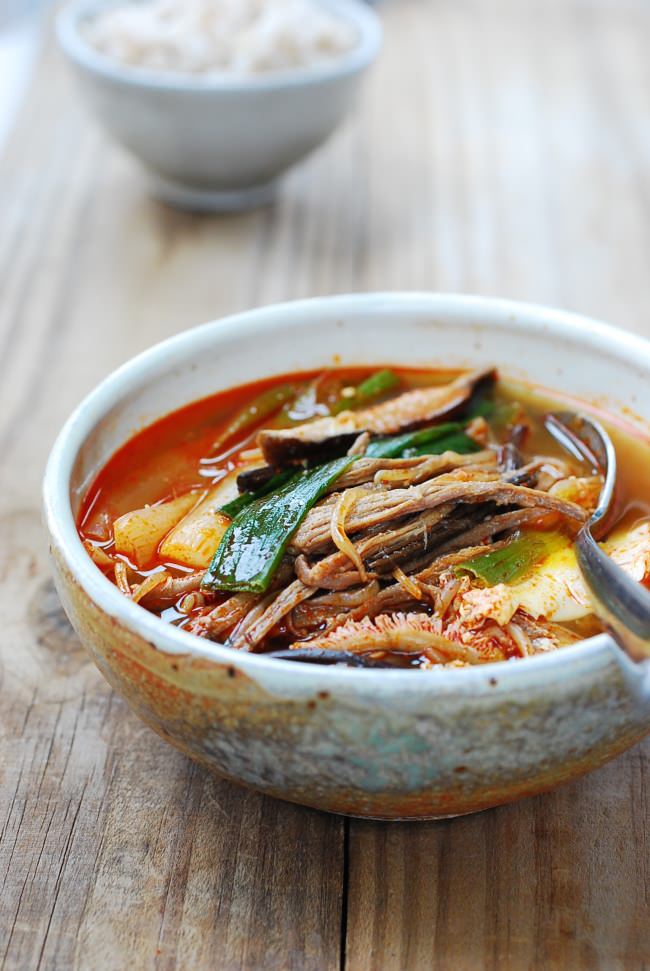
Seasoning
Sesame oil is essential, and it'southward typically infused with gochugaru (Korean blood-red chili pepper flakes) for a chili oil event. But estrus the oil and mix with the gochugaru. For added layers of flavor, I usually add together very pocket-sized amounts of gochujang (Korean red chili pepper paste) and doenjang (Korean fermented soybean paste). Merely, absolutely optional! This yukgaejang recipe is non fiery hot. Adjust the heat level according to your taste.
Variations
If you want your soup to be extra rich, yous tin also boil some beefiness bones (such every bit neck bones) with the meat. Or, I sometimes add some pre-made seolleongtang broth (aka milky bone broth or sagol yuksu) to eddy the meat considering I normally take some in my freezer. You tin can also use store-bought milky beef bone broth, which is usually labeled as sagol yuksu (사골육수) or sagol gomtang (사골곰탕).
You can also use anchovy broth or dashima broth to boil the beef to add together actress flavors to the resulting broth.
I ordinarily drizzle lightly beaten eggs over the soup at the end of cooking. Some people prefer sparse egg omelette garnish (jidan, 지단). You tin skip the eggs if you want.
Noodles are also a dandy addition! Dangmyeon (당면), sweet spud starch noodles (aka japchae noodles), is typical for this soup.
Instant Pot yukgaejang
Lately, I've been using my Instant Pot to brand this dish. It really is much quicker to cook a tough cut of meat, and I love how tender and moist the beefiness turns out.
Merely add together the meat, onion, and optional radish to the Instant Pot along with water. Yous will need much less water because it doesn't evaporate in the Instant Pot. I use almost 10 cups for this recipe.
Then, cook on Transmission Loftier for 30 minutes. When information technology's done cooking, release the force per unit area afterwards x minutes. Remove the meat, and strain the goop. Follow the remainder of the recipe, and use the Sauté role to cease up.
More than soup recipes
xv Korean soup recipes
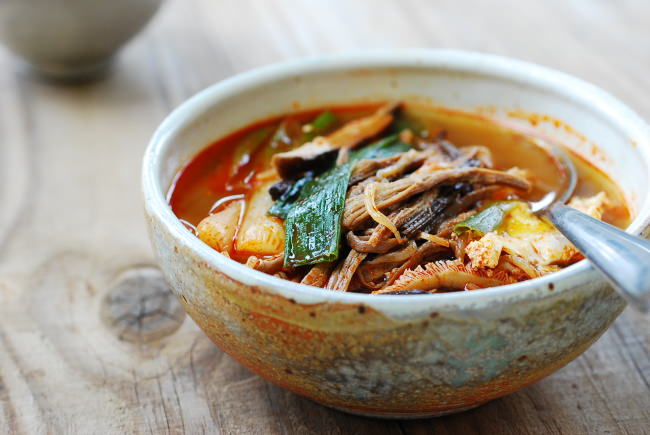
For more Korean cooking inspirations, follow along on YouTube , Pinterest , Twitter , Facebook , and Instagram .
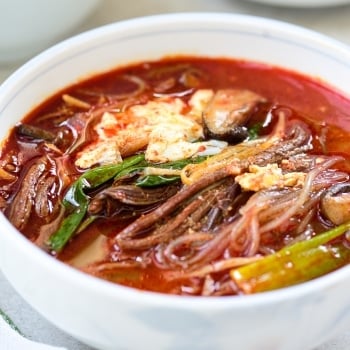
- i ounce dried gosari, 고사리 (fernbrakes) - most 1 cup rehydrated
- one pound beef brisket, 양지머리 (or flank steak or shank meat)
- 1/2 onion (practise not cut off the stem)
- viii ounces Korean radish (mu, 무), cut into big chunks - optional
- 8 ounces bean sprouts (sukju, 숙주)
- 3 dry shiitake mushrooms, soaked (or 2 ounces fresh shiitake or oyster mushrooms)
- ii - iii bunches scallions (or 2 or three stalks of Korean daepa (large variety scallion) ii or 3 stalks of Korean daepa (big variety scallion)
Seasonings
- 2 tablespoons sesame oil
- 2 tablespoons gochugaru, 고추가루 (red chili pepper flakes) - 2.5 to three TB for spicier soup
- one tablespoon minced garlic
- 2 tablespoons guk ganjang, 국간장 (soup soy sauce), divided
- one teaspoon gochujang, 고추장 (red chili pepper paste) - optional
- 1 teaspoon doenjang, 된장 (soybean paste) - optional
- table salt and pepper
Optional additions
- ii eggs lightly browbeaten
- iii ounces dangmyeon (당면), starch noodles soaked in warm water for 20 minutes
-
Add the gosari and 4 cups of water to a modest pot. Eddy over medium heat, covered, until tender. Mine only took nearly xxx minutes, but the fourth dimension can vary significantly depending on gosari. Plow the heat off and permit it absurd in the cooking water. When fix to use, rinse in cold water and drain. Cut into 4-inch lengths, removing tough ends of the stems, if any. (Come across note 1.)
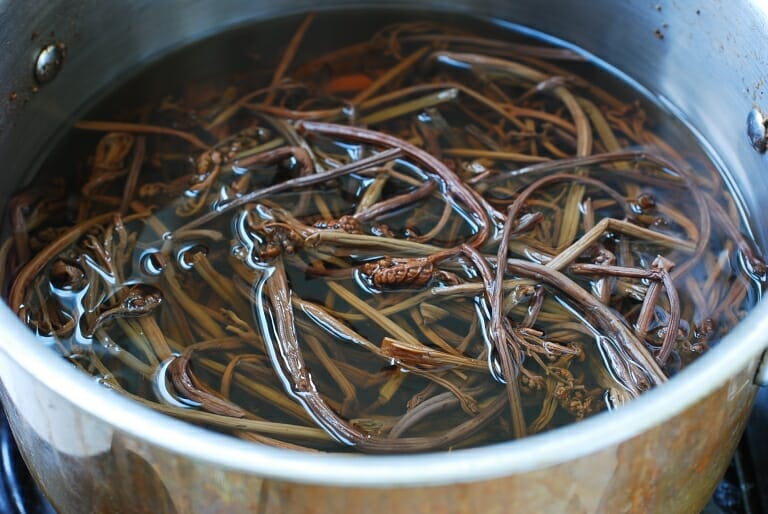
-
In a large pot, bring the meat, onion, and optional radish, to a boil in 14 cups of water (encounter note 2 for other goop options). Reduce the heat to medium, and skim off the scum. Boil, covered, until the meat is tender plenty for shredding, about i hr. Pull a string of meat off and check the tenderness. Let the meat cool a scrap in the cooking liquid. Discard the vegetables, reserving the stock in the pot. Spoon off any visible fatty. The broth should be about seven to 8 cups.
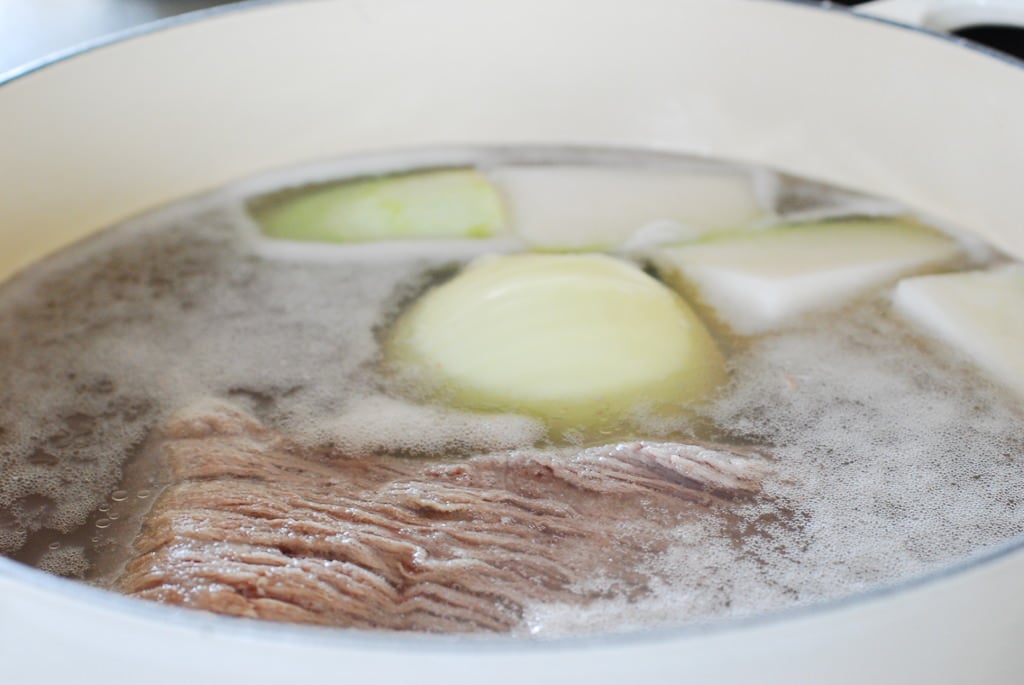
-
When the meat is cool enough to handle, shred into about 3 to 4-inch strips.
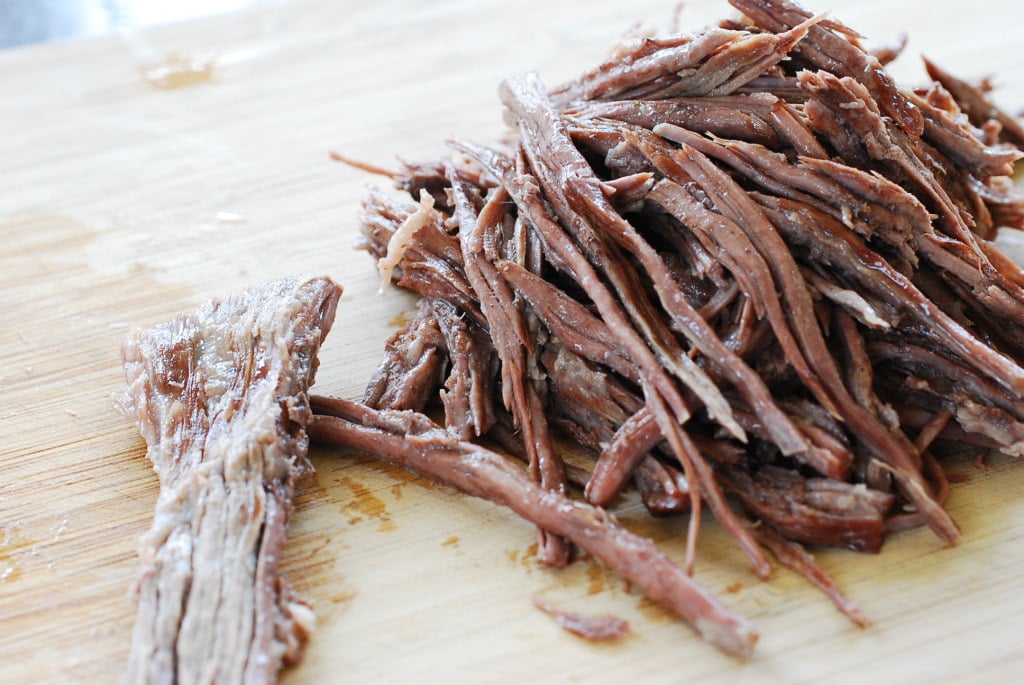
-
Blanch the bean sprouts in boiling water for a minute. Wash with cold h2o and drain. Cut the scallions into iv-inch lengths. Thinly slice the soaked mushrooms.
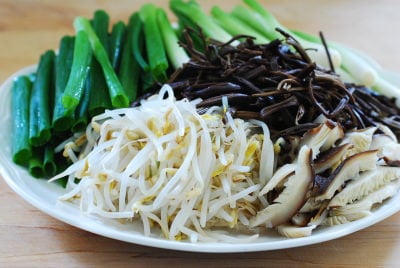
-
In a pan, heat the sesame oil until hot over depression heat and stir in the chili pepper flakes. Turn the heat off as soon as the oil starts to turn reddish and the chili pepper flakes become a bit glutinous. This just takes a few seconds. Exercise non burn the flakes.
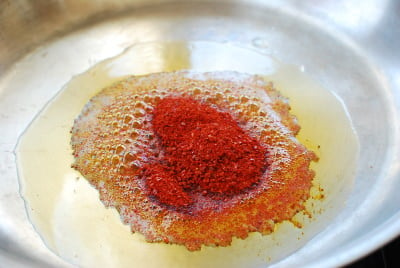
-
Add together the meat, gosari, mushrooms, i tablespoon soup soy sauce, and garlic to the pan. Toss well to coat everything with the oiled chili pepper flakes.
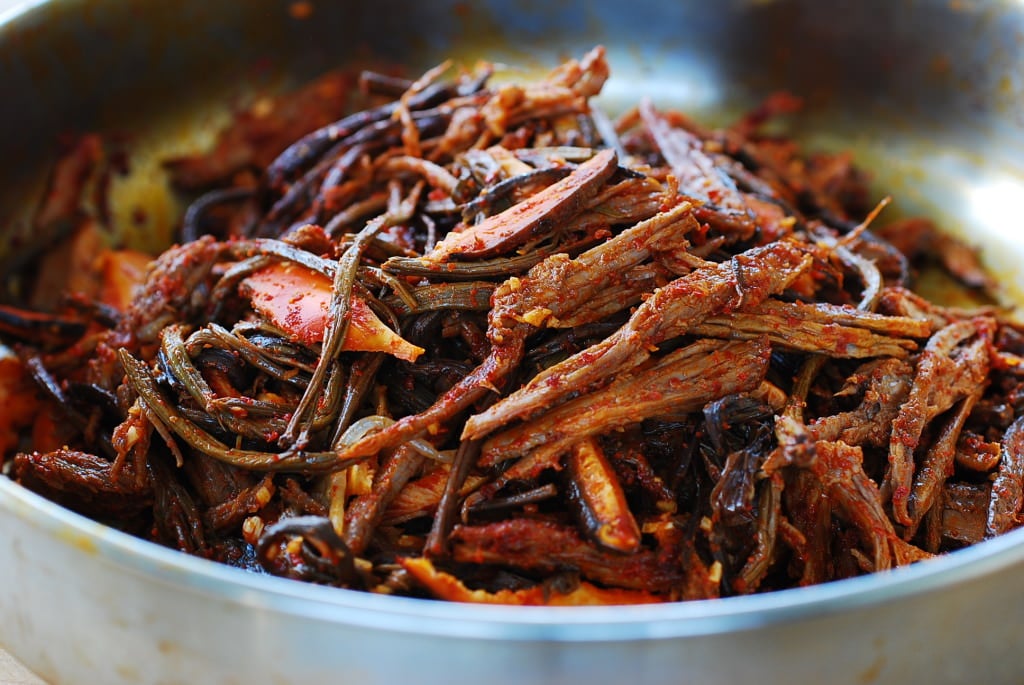
-
Add the meat and gosari mixture to the broth. Stir in 1 tablespoon of soup soy sauce, optional gochujang and doenjang, and boil over medium loftier heat, covered, for most x minutes.
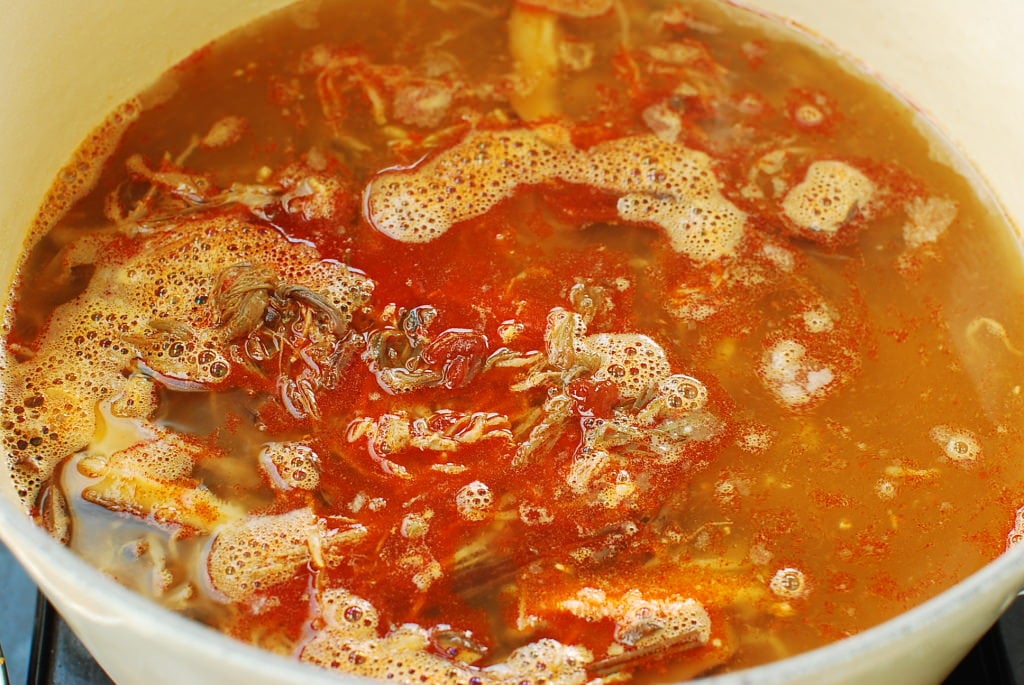
-
Throw in the bean sprouts and scallions, and boil over medium heat for another x minutes. Add together common salt (1 teaspoon or more) and pepper to taste. Within a few minutes before turning the heat, add together the optional noodles. Slowly drizzle the optional eggs over the humid soup and turn the heat off. Serve with rice.
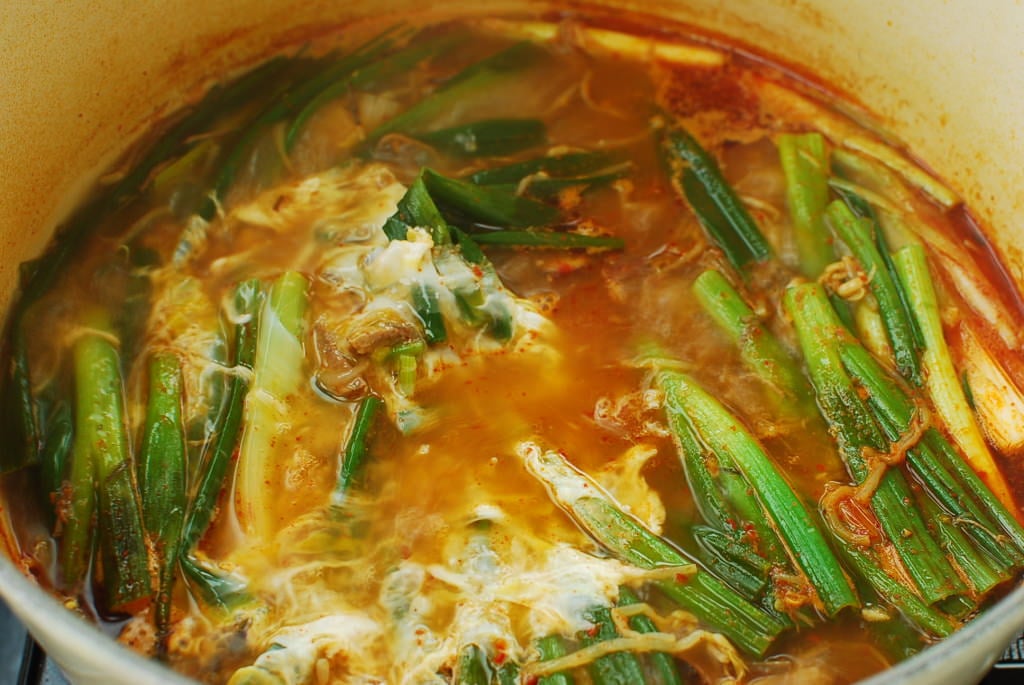
Instant Pot method
-
Add the meat, onion, and optional radish to the Instant Pot along with 10 cups of water.
-
Melt on Manual High for 30 minutes. When information technology's done cooking, release the pressure afterward 10 minutes. Remove the meat, and strain the broth. Follow the rest of the stove acme recipe. Use the Sauté function for steps 7 and 8 to stop up.
- You can besides soak the gosari for several hours to soften and then boil over medium estrus until tender.
- You tin use a combination of milky beef os broth and water if you want. Add four to 6 cups or more. And but reduce water past the same corporeality. You tin can also boil the beef in dashima goop or anchovy broth to add another layer of flavour to the soup.
This recipe was originally posted in Dec 2014. I've updated it here with new photos, more information and pocket-size improvements to the recipe.
Source: https://www.koreanbapsang.com/yukgaejang-spicy-beef-soup-vegetables/
Post a Comment for "What Veggies Go Good in Korean Beef?"